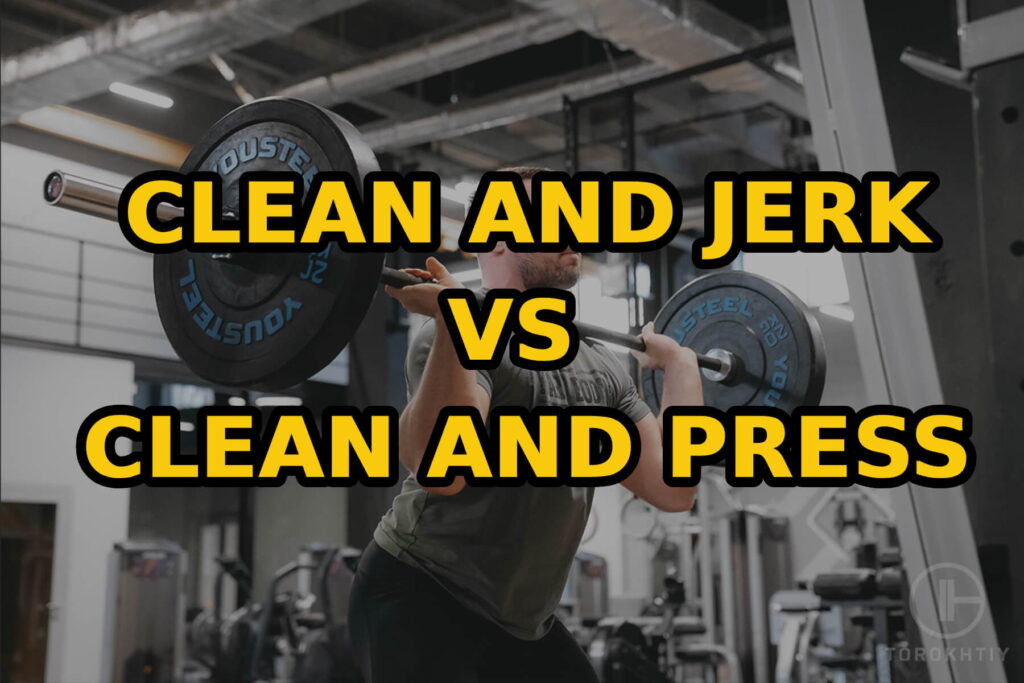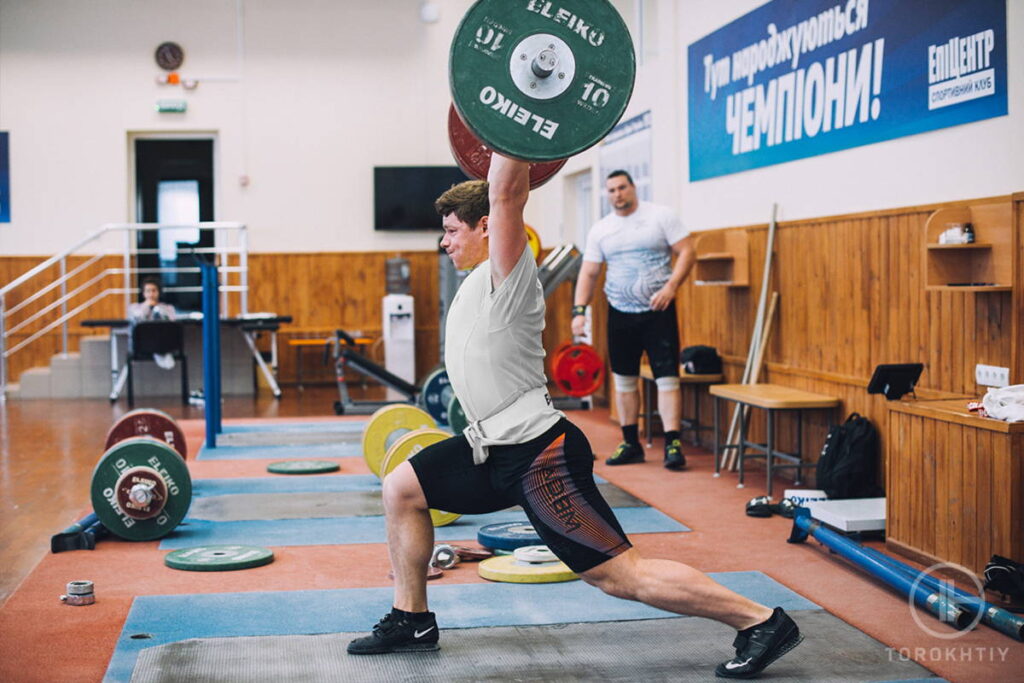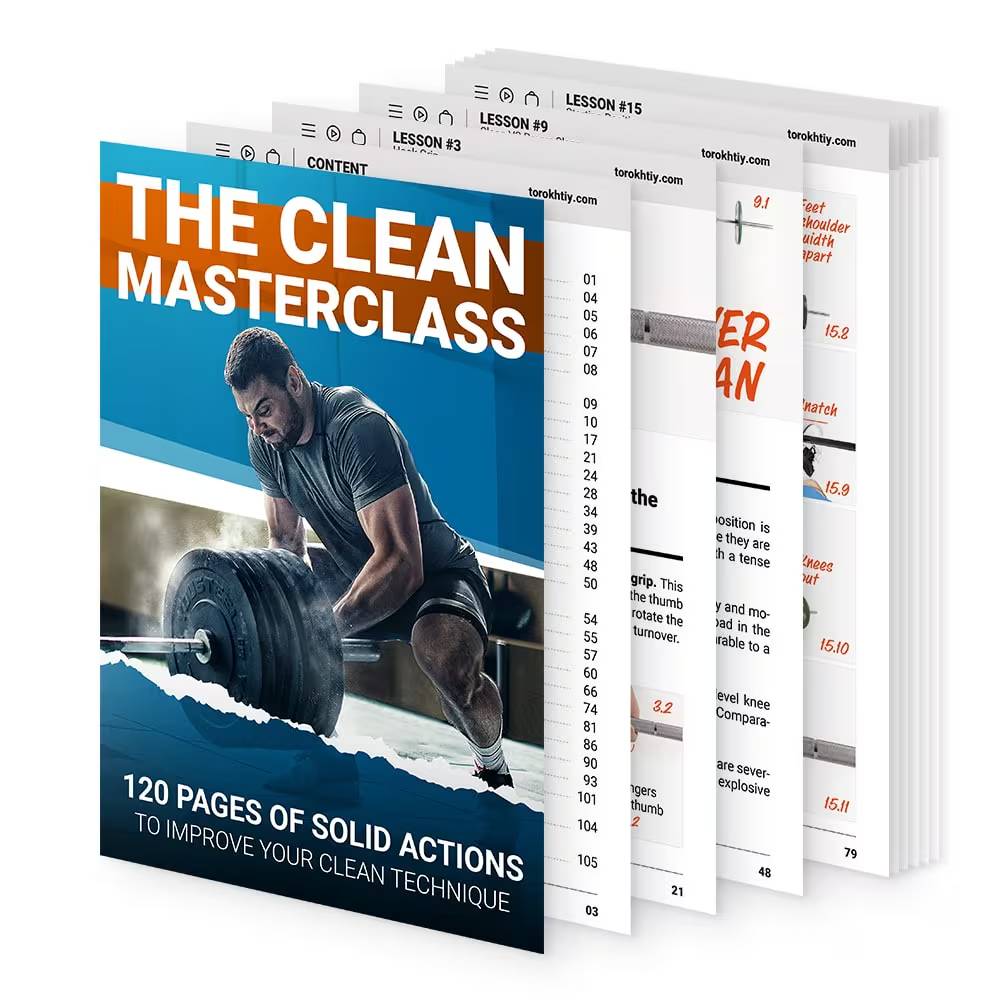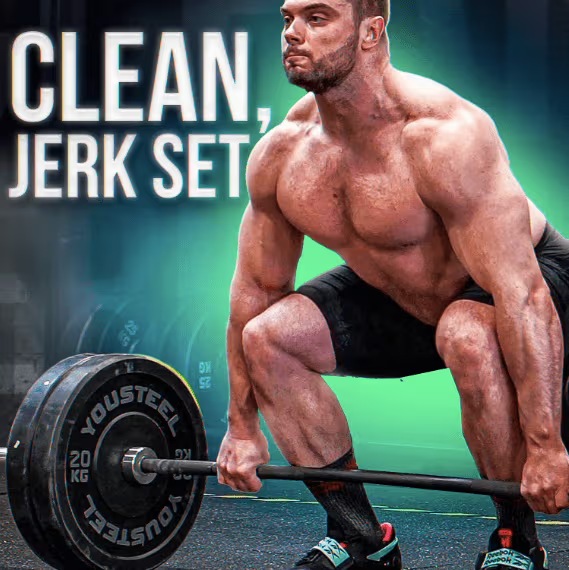Clean and Jerk vs Clean and Press: Difference Explained
Author:
Reviewed by:
(21 years of Oly Lifting experience)
Unlock your full potential by engaging with our experts and community! Have questions about your fitness journey or looking for expert advice on weightlifting techniques? Don’t hesitate — leave a comment below and Sergii Putsov will provide a personalized answer and insights to help you reach your goals.
Torokhtiy is reader-supported. Some links are affiliate links, and we may earn a commission at no extra cost to you. See our disclosure page for details.
There are many ways to lift a barbell overhead. The clean is a strong exercise that lifts the bar to the shoulders. Then you may press or jerk. The press is a basic upper-body strength drill, jerk is a magical method for lifting huge weights quickly. Let’s compare clean and jerk vs clean and press in terms of technique and application to assist you attain your goals.
The main distinction is how you end, since the CLEAN is in both exercises. While the Olympic JERK mostly depends on leg power, the PRESS relies on upper body strength.

What Is Clean And Jerk?
Weightlifters perform C&J as part of the competition, and their main task is to lift the heaviest weight.
During the Clean & Jerk, the following muscles work: quadriceps, glutes, extensors of the spine and core muscles, deltoid muscles and triceps.
Weightlifters perform C&J as part of the competition, and their main task is to lift the heaviest weight.
During the Clean & Jerk, the following muscles work: quadriceps, glutes, extensors of the spine and core muscles, deltoid muscles and triceps.
Clean And Press Pros & Cons
Positives:
Could be better:
How To Do Clean and Jerk?
The C&J is a technically difficult exercise, and even professional weightlifters hone their technique for many years. The Clean and Jerk implies a huge amplitude and the movement itself consists of certain stages:
Starting Position in CLEAN
The task of this position is the strongest and most effective angles for moving the barbell to the knees joints in preparation for its acceleration.
Basic positions:
- feet shoulder width apart
- hands hold the bar a bit wider the shoulders with a hookgrip
- the toes are moved lightly to the sides; the COG lies in the midfoot
- the lower spine is straight and tight
- the projection of the bar should pass through the middle of the foot, and the shoulders should be above the barbell
Pull
With the help of a powerful effort of the legs and back, the athlete lifts the bar from the platform to power position.
Power position
This is the phase of the athlete’s movement, when the hips and knee joints are bent, he stands on a flat foot, the barbell is pressed to the body, the knees & shoulders are on the same line or slightly cover the barbell. The power position provides active jump, which creates the maximum power of the exercise due to the synchronized work of the legs & torso.
Turnover & catch
After full extension of the hips and knees, when the barbell is at the solar plexus, the athlete must instantly switch the direction of movement down and, rotating the elbows as quickly as possible, meet the weight in a squat position. When studying about the clean progression, inexperienced athletes sometimes ignore the importance of elbow rotation in the Clean Turnover. Learn more here – LINK.
Recovery
Right after catching the barbell in a squat, the athlete must stand up. The fast transition from eccentric to concentric action is an essential technical component of the recovery period. In essence, this is the muscle mode change required to descend towards the deep squat and then instantly stand back up. To actively rise from the full squat, an athlete must practice the spring skill.
Jerk starting position
After recovery from a low squat, the lifter has a couple of seconds to prepare for the second stage – Jerk. Here is how he must set up: the elbows must be kept turned away from each other so that the barbell does not lie on the clavicula, but on deltoids. The chest should be open and the torso tight, the COG is in the midfoot or slightly shifted to the heels, the arms must be relaxed.
Dip & Drive
An important condition for a high result in the clean and jerk is the quality of the phases – dip and drive. Athletes often dip too fast or too short, and drive up not powerful enough or not in full amplitude.
Catch
To perform a successful attempt, the athlete must fix the position of the bar above his head, straighten his legs, and place his feet in one line.
What Is Clean and Press?
Clean And Press Pros & Cons
Positives:
Could be better:
How To Do Clean And Press?
In this complex, CLEAN is performed with identical technical characteristics, as in the standard C&J. The standing press, sometimes referred to as the strict press or shoulder press, is a mainly strength-building exercise. The athlete must use their upper body strength alone to move a barbell from the front rack to position in overhead. In the press, there is no momentum produced to assist the lift; all the force needed to move the weight overhead goes from the upper body. Starting with a tight core, the movement transfers strength to the shoulders and arms. The press lift fully collapses without a strong core, with the hips, core, and pelvis arching to push themselves in front of the bar. Your legs should not move, and your body should remain as still as possible.
The press execution:
- Clean to a front rack position
- with the grip a bit broader than shoulder width, the bar rests on the shoulders
- the stance is around hip width, and the elbows are placed beneath & in front of the bar
- press it into an overhead position
Follow us!

Free!
Get a 2-week Weightlifting Program as a bonus for the subscription to kickstart your training plan!

Free!
Clean and Jerk vs Clean and Press Comparison
The difference between clean and press and clean and jerk is how you finish The CLEAN is included in both exercises. While the Olympic JERK is an explosive exercise that mostly relies on leg drive, the PRESS primarily relies on total upper body strength.
1. How To Do Clean And Press?
C&J is one of the competitive exercises in the Olympic weightlifting program. Therefore, for professional weightlifters, this exercise is always the priority of the training program.
2. Clean And Press Is An Accessory Exercise
Clean and press used by both weightlifters and just strength athletes as a warm-up before working with large weights in basic exercises, and also as a general strength complex in the off season.

3. Lifting Weight
Simply said, you definitely can lift more in the Olympic JERK in comparison with the PRESS because the press requires you to just engage triceps, deltoids & upper back. To drive the barbell off your shoulders in the JERK, it is possible to fully rely on the strength and power of leg muscles. The primary purpose of your arms is to catch the barbell when it is in overhead position.
4. The Difficulty Level
The strict press is quite easy, but the Olympic jerk requires way more skill. To execute it successfully, you need proper form, accurate timing, and strong coordination. When practicing to jerk correctly, the strict press is frequently employed.
5. Hypertrophy Vs Strength
Both exercises enable intense training, although the majority of athletes can jerk much more than they ever press. In light of this, the jerk exercise is a superior demonstration of complete body power. The press, on the other hand, isolates your upper back, triceps, and deltoids. This makes it more suitable for increasing muscle mass or enhancing pressing strength in general.
FAQ
What’s Harder Clean and Press vs Clean and Jerk?
In the strict press, you can only use upper body muscles, so you can’t lift as much weight as you can with the jerk. In the jerk, it is possible to use all the power of leg muscles to lift the barbell in overhead.
Do Clean and Presses Build Muscle?
Clean and press exercises make lower & upper body muscles stronger, including your hamstrings, quads, glutes, shoulders and arms muscles, lower & upper lower back. It also develops abdominal muscles as well.
Conclusion
Clean & Press and C&J seem similar, but their methodologies are different. The press is for hypertrophy or off-season activity, while the jerk develops power. Both can increase your performance and make a better athlete. So, are you team Clean & Press or C&J? Did I miss anything important? Talk to me in the comments!
Also read:
Why Trust Us?
With over 20 years in Olympic weightlifting, strength training, nutrition coaching, and general fitness our team does its best to provide the audience with ultimate support and meet the needs and requirements of advanced athletes and professional lifters, as well as people who strive to open new opportunities and develop their physical capabilities with us.
By trusting the recommendations of our certified experts in coaching, nutrition, and sports training programming, as well as scientific consultants, and physiotherapists, we provide you with thorough, well-considered, and scientifically proven content. All the information given in the articles concerning workout programming, separate exercises, and athletic performance, in general, is based on verified data.
The product testing process is described in more detail here.
Author: Sergii Putsov
Head of Sport Science, PhD
Best Results: Snatch – 165 kg,
C&J – 200 kg
Sergii Putsov, Ph.D., is a former professional weightlifter and National team member, achieving multiple medals in the 94 kg weight category at national competitions. With a Master’s degree in “Olympic & Professional Sport Training” and a Sport Science Ph.D. from the International Olympic Academy, Greece, Sergii now leads as the Head of Sport Science. He specializes in designing training programs, writing insightful blog articles, providing live commentary at international weightlifting events, and conducting educational seminars worldwide alongside Olympic weightlifting expert Oleksiy Torokhtiy.
Reviewed by: Oleksiy Torokhtiy
Olympic Weightlifting Champion, PhD in Sport Science
Best Results: Snatch – 200 kg,
C&J – 240 kg
Oleksiy Torokhtiy is a professional athlete boasting 20 years of experience in Olympic weightlifting. With multiple European and World titles under his belt, he has showcased his prowess in two Olympic Games (Beijing 2008 and London 2012). Upon concluding his illustrious career, Oleksiy dedicated himself to coaching. By 2022, he had conducted over 200 weightlifting seminars worldwide. He is the visionary behind an international sportswear and accessories brand known for its motto, “Warm Body Cold Mind.” Additionally, he is an esteemed author and the creator of a series of training programs and eBooks.






Still have questions after reading our article? Unlock your full potential by engaging with our experts and community! Don’t hesitate — leave a comment below and Sergii Putsov will provide a personalized answer and insights to help you reach your goals.